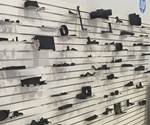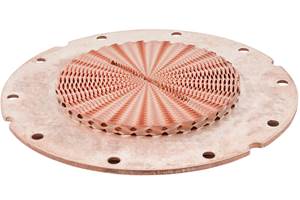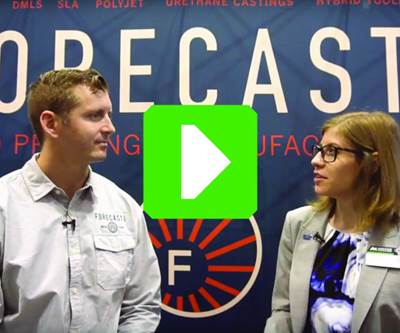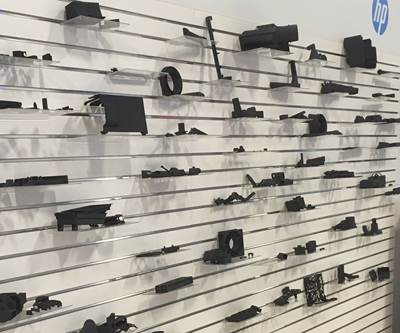Jabil Moves Toward Production with HP Additive Manufacturing Technology
As the first manufacturer to accept delivery of HP Jet Fusion 3D printers, Jabil has its sights set on additive production at scale.
HP made a splash in 2016 with the release of its Multi Jet Fusion system, a 3D printing technology with the capability to print quickly and at high resolution. The promise of the technology is the advance of 3D printing from short-run manufacturing to production at full scale. Now, Jabil, a supply chain management and electronic manufacturing company, has validated that promise and is preparing to make that very advance this year. The company sees various customer applications that could benefit from production 3D printing.
Jabil has been working with HP for the better part of a year to help bring the Multi Jet Fusion 3D platform to market. As a foundational partner, Jabil received an early unit in July of 2016 to help characterize and develop the Multi Jet Fusion process. Now, the company has taken delivery of two Jet Fusion 4200 machines at its Jabil Blue Sky Innovation Center in San Jose, California. Unlike their predecessor, these machines are destined for production.
In the past, Jabil’s use of 3D printing has been primarily tied to its engineering services, where prototypes and product models are used frequently to prove out a design. Following product development, there’s typically a transition to a molding process which might involve further 3D-printed objects such as tooling or mold templates. Then, molds are built and the part moves into production. This process makes sense for large volumes of plastic parts, but for runs in the thousands or hundreds of units—production scale for many parts—creating a mold may not be cost-effective. And if production must take place at more than one location, more than one mold must be made.
The HP platform stands to change this model for Jabil, according to John Dulchinos, vice president of global automation and 3D printing at Jabil. With other plastic 3D printing technologies, he says, there is usually a trade-off. To print parts quickly means sacrificing functionality or quality, while producing parts with mechanical integrity or good aesthetics means lengthy development times.
“Multi Jet Fusion technology starts to intersect the challenges that have limited 3D printing as a real production solution—speed, cost, quality and mechanical integrity,” Dulchinos says. “It’s able to crisscross that matrix and create parts that have characteristics comparable to injection molding, with quality and consistency, at a level of scale with fast product introduction cycles.”
HP’s Jet Fusion technology is a sintering-like process that takes place in a powder bed. But rather than using a laser to sinter material together, the Jet Fusion 3D printer first jets a fusing agent into the powder and then melts the designated powder a full layer at a time. Because the fusion process is not performed point by point as with laser sintering or FDM, cycle times are much faster, regardless of how intricate or densely populated the layer. With the 4200 model’s 1,200-dpi XY resolution and layer thickness ranging from 0.07 to 0.12 mm (0.0025" to 0.005"), the parts produced are of a quality comparable to sintered ones, but with a faster turnaround. For Jabil, shorter cycle times and the ability to pack parts onto the printer’s 16 × 12-inch bed without sacrificing speed are key to bringing the technology into full-scale production.
Jabil is currently working to identify the best production applications for Multi Jet Fusion, and sees two classes of products that can benefit. The first, says Dulchinos, is any product “where personalization creates value, whether that’s footwear, wearable devices, hearing aids or earbuds. The ability to build a product that’s personalized to the user is a good use case for this technology.”
Additive manufacturing lends itself to mass customization, or small lots of quickly produced specialized products. One example is shoe insoles like those designed by Superfeet, a Jabil customer that offers insoles in a variety of shapes and sizes. Multi Jet Fusion technology is making it possible to produce more personalized and customized insoles than would be cost effective using traditional manufacturing methods. Jabil sees this technology as an enabler of customized products at a level of scale that is competitive with other technologies, while allowing Superfeet to change its delivery paradigm and print custom insoles on-demand in retail locations.
The second is products made in lower volumes, though at volumes much higher than what has been practical for 3D printing technologies to date. According to Dulchinos, the break-even point below which 3D printing is a viable alternative to injection molding is typically as high as around 20,000 to 30,000 units.
“Across the supply chain of plastic parts that we source, 80 percent have annual volumes below 20,000 units,” he says. “With a technology like Multi Jet Fusion that can produce production-grade parts, we think many of those will be good candidates for this technology.” The possibilities extend across industries, including parts for the automotive, energy, healthcare and industrial sectors.
In addition to exploring end use cases, the company is also working to solve the challenges that will be necessary to bridge the gap between prototyping and production. These include continuing to characterize the Multi Jet Fusion process, developing consistent processes for secondary operations such as finishing and coating, and revamping quality processes. A CT scanner from Carl Zeiss is already employed to assist the company in validating its 3D-printed parts. Secondary automation is another area of exploration.
Though there are hurdles to be overcome, Jabil sees great potential in additive manufacturing and 3D printing specifically as key to distributed manufacturing and bringing production closer to its customers. Inserting the Jet Fusion printers into a production workflow is the next step toward achieving this vision of digital manufacturing.
“We’re confident that we will be producing production parts in 2017 using this technology,” Dulchinos says.
Related Content
With Electrochemical Additive Manufacturing (ECAM), Cooling Technology Is Advancing by Degrees
San Diego-based Fabric8Labs is applying electroplating chemistries and DLP-style machines to 3D print cold plates for the semiconductor industry in pure copper. These complex geometries combined with the rise of liquid cooling systems promise significant improvements for thermal management.
Read MoreActivArmor Casts and Splints Are Shifting to Point-of-Care 3D Printing
ActivArmor offers individualized, 3D printed casts and splints for various diagnoses. The company is in the process of shifting to point-of-care printing and aims to promote positive healing outcomes and improved hygienics with customized support devices.
Read MoreVulcanForms Is Forging a New Model for Large-Scale Production (and It's More Than 3D Printing)
The MIT spinout leverages proprietary high-power laser powder bed fusion alongside machining in the context of digitized, cost-effective and “maniacally focused” production.
Read MoreThis Drone Bird with 3D Printed Parts Mimics a Peregrine Falcon: The Cool Parts Show #66
The Drone Bird Company has developed aircraft that mimic birds of prey to scare off problem birds. The drones feature 3D printed fuselages made by Parts on Demand from ALM materials.
Read MoreRead Next
Video: 3D Printing Is a Complement and Competitor to Injection Molding
Ken Burns of Forecast 3D, an early adopter of HP Multi Jet Fusion, sees 3D printing as both a complement and a competitor to injection molding. He shares why in this interview.
Read MoreOvercoming Obstacles to Bring AM into the Supply Chain
A conversation with Jabil’s John Dulchinos and HP’s Stephen Nigro illustrates some of the challenges in integrating additive manufacturing into a supply chain for production parts.
Read MoreBike Manufacturer Uses Additive Manufacturing to Create Lighter, More Complex, Customized Parts
Titanium bike frame manufacturer Hanglun Technology mixes precision casting with 3D printing to create bikes that offer increased speed and reduced turbulence during long-distance rides, offering a smoother, faster and more efficient cycling experience.
Read More
.jpg;width=70;height=70;mode=crop)



















